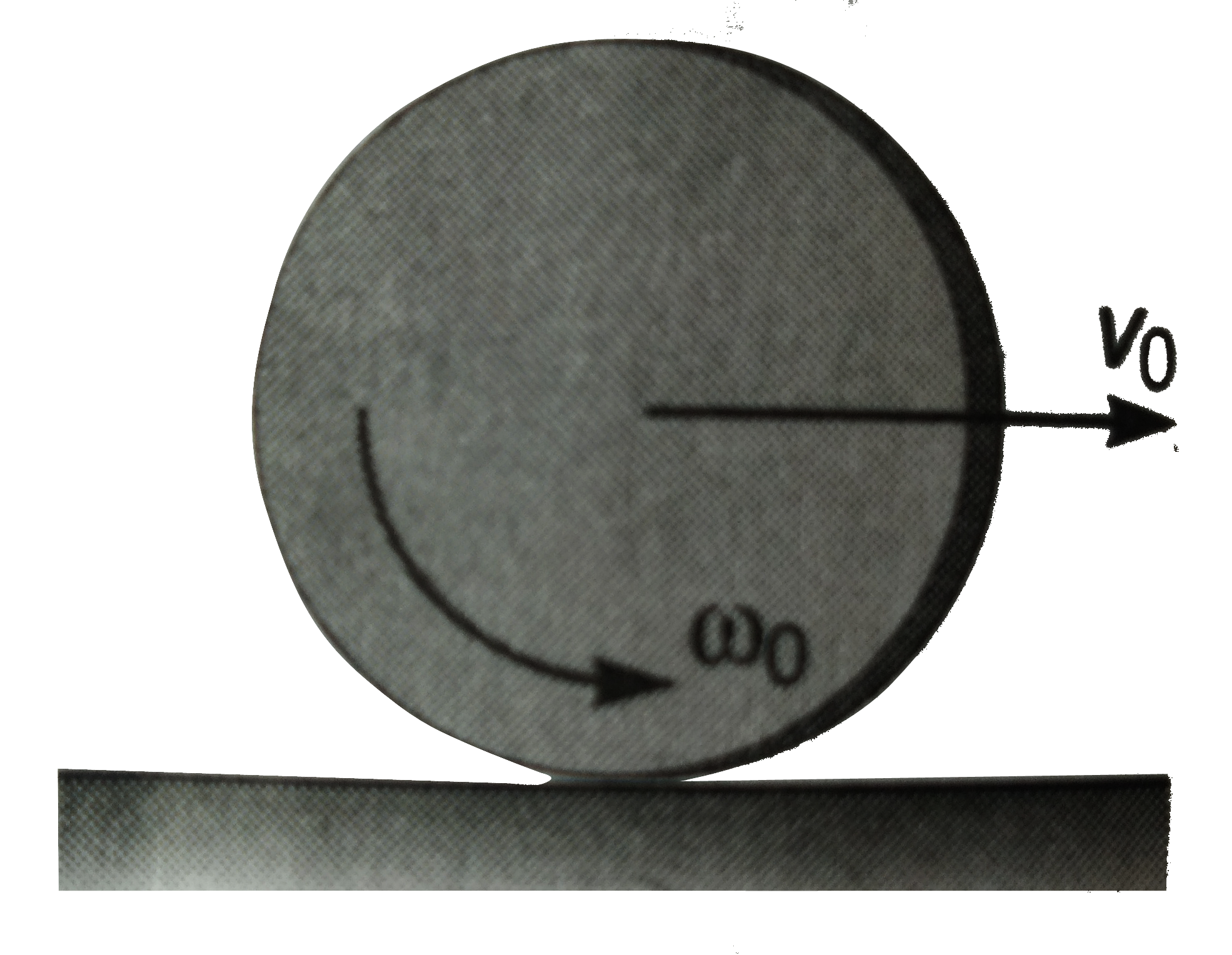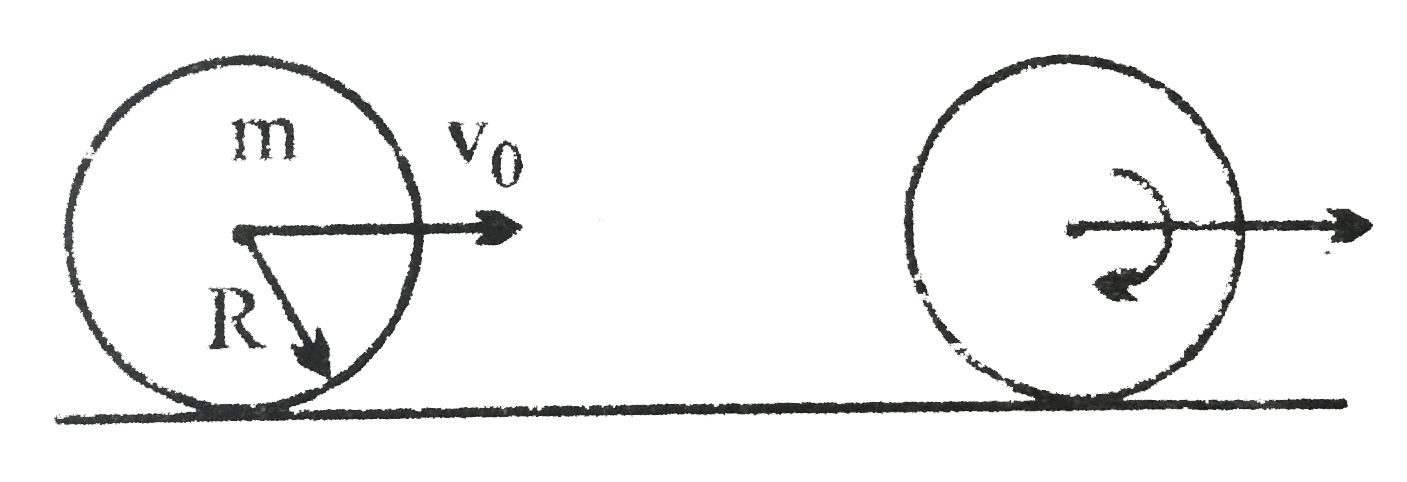A uniform disc of mass m and radius r is projected horizontally with velocity v0 on a rough horizontal floor so that it starts off with a purely sliding motion at t = 0. At t =t0 seconds it acquires a purely rolling motion.

(a) Calculate the velocity of the centre of mass of the disc at t = t0
(b) Assuming coefficient of friction to be μ, calculate t0
(c) Find the work done by the frictional force as a function of time.
(d) Find total work done by the friction over a time t much longer than t0

F.B.D. of the disc.
When the disc is projected it starts sliding and hence there is a relative motion between the points of contact and surface. Therefore, frictional force acts on the disc in the direction opposite to the motion.
(a) Now for translational motion
→ac.m.=→fm
f=μN (as it slides)<br>= mu m g<br>rArr" "a_(c.m.) =- mu "g, negative sign indicates that a"_(c.m.) "is opposite to v"_(c.m.)<br>rArr" "v_(c.m.(t)) = v_(0) - mu g t_(0)<br>rArr" "t_(0) = ((v_(0) - v))/(mu g), "where v"_(c.m.(t_(0))) = v" "...(i)<br>Forrotationalmotionaboutcentre<br>tau_(f) + tau_(mg) = I_(c.m.) alpha" "rArr" "mu g r = (mr^(2))/(2) alpha<br>alpha = (2mu g)/(r) " "...(ii)<br>Therefore,omega_((1_(0))) = 0 + (2 mu g)/(r)t,<br>Usingomega_(1) = omega_(0) + alpha t<br>rArr" "omega = (2 (v_(0) - v))/(r)" "...(iii)<br>Using(i)<br>(v_(cm))_(t_(0)) = omega r<br>rArr" "v = 2(v_(0) - v)" ""using (iii)"<br>rArr" "v = (2)/(3) v_(0)<br>(b)Pu∈gthevalueofv∈equation(i)<br>we≥tt_(0) = (v_(0))/(3 mu g)<br>(c)Workdo≠bytheictionalforceisequal→chan≥∈K.E.<br>rArr" "W_("friction") = (1)/(2) m(v_(0) - mu g t)^(2-) + (1)/(2) ((mr^(2))/(2))((2 mu g t)/(r))^(2) - (1)/(2) mv_(0)^(2)<br>= m ((3)/(2) mu^(2) g^(2) t^(2) - v_(0) mu g t),"for t" le t_(0)<br>(d)Fortimet gt t_(0),workdo≠bytheictioniszer⊙<br>rArrForlon≥rtime→talworkdo≠<br>m ((3)/(2) mu^(2) g^(2) t^(2) - v_(0) mu g t)<br>rArr" "W = - m v_(0)^(2)//6
Topper's Solved these Questions
- BOOK - FIITJEECHAPTER - ROTATIONAL MECHANICSEXERCISE - SOLVED PROBLEMS (OBJECTIVE)14videos
ROTATIONAL MECHANICS
- BOOK - FIITJEECHAPTER - ROTATIONAL MECHANICSEXERCISE - ASSERTION REASONING TYPE1videos
ROTATIONAL MECHANICS
- BOOK - FIITJEECHAPTER - ROTATIONAL MECHANICSEXERCISE - COMPREHENSION - IV2videos
ROTATIONAL MECHANICS
- BOOK - FIITJEECHAPTER - PHYSICS PART2EXERCISE - Numerical Based Question Decimal Type6videos
PHYSICS PART2
- BOOK - FIITJEECHAPTER - SEMICONDUCTOR AND DEVICEEXERCISE - SOLVED PROBLEMS Objective: Level-I20videos
SEMICONDUCTOR AND DEVICE
Similar Questions
A uniform disc of mass m and radius R is projected horizontally with velocity v0 on a rough horizontal floor so that it starts off with a purely sliding motion at t=0. After t0 seconds, it acquires pure rolling motion as shown in the figure.
(a) Calculate the velocity of the center of mass of the disc at t0.
Assuming that the coefficent of friction to be μ, calculate t0.
 View Solution
View SolutionA uniform disc of mass m and radius R is projected horizontally with velocity v0 on a rough horizontal floor so that it starts off with a purely sliding motion at t=0. After t0 seconds, it acquires pure rolling motion as shown in the figure.
(a) Calculate the velocity of the center of mass of the disc at t0.
Assuming that the coefficent of friction to be μ, calculate t0.
 View Solution
View Solution
Knowledge Check
- Question 1 - Select One
A uniform ring of mass 'm' and radius 'R' is projected horizontally with velcoty v0 on a rough horizontal floor, so that it starts off with a purely sliding motion and it acquires a pure rolling motion after moving a distance d. If the coefficient of friction between the ground and ring is μ, then work done by the friction in the process is
A−μmgdB−14mv20CμmgdD−18mv20 - Question 2 - Select One

A disc of mass M and radius R is rolling purely with centre's velcity v0 on a flat horizontal floor when it hits a step in the floor of height R/4 The corner of the step is sufficiently rough to prevent any slippoing of the disc against itself. What is the velocity of the centre of the disc just after impact?A4v0/5B4v0/7C5v0/6Dnone of these
A uniform disk of mass m and radius R is projected horizontally with velocity v0 on a rough horizontal floor so that it starts off with a purely sliding motion at t=0. After t0 seconds it acquires a purely rolling motion as shown in figure.
(i) Calculate the velocity of the centre of mass of the disk at t0.

(ii) Assuming the coefficient of friction to be μ calculate t0. Also calculate the work done by the frictional force as a function of time and the total work done by it over a time t much longer than t0.View SolutionA uniform disc of mass m and radius R is projected horizontally with velocity v0 on a rough horizontal floor so that it starts with a purely sliding motion at t= 0. After t0 seconds it acquires a purely rolling motion.
(a) Calculate the velocity of the centre of mass of the disc at t0
(b) Assuming the coefficient of friction to be μ, calculate to. Also calculate the work done by the frictional force as a function of time and the total work done by it over a time t muchlonger than t0.View SolutionA uniform ring of mass 'm' and radius 'R' is projected horizontally with velcoty v0 on a rough horizontal floor, so that it starts off with a purely sliding motion and it acquires a pure rolling motion after moving a distance d. If the coefficient of friction between the ground and ring is μ, then work done by the friction in the process is
View Solution
A disc of mass M and radius R is rolling purely with centre's velcity v0 on a flat horizontal floor when it hits a step in the floor of height R/4 The corner of the step is sufficiently rough to prevent any slippoing of the disc against itself. What is the velocity of the centre of the disc just after impact?View SolutionA body of mass 2kg is kept on a rough horizontal surface as shown in the figure. If coefficient of friction is 0.5, find the work done by frictional force in the interval t=0 to t=5sec
 View Solution
View SolutionA disc is in the condition of pure rolling on the horizontal surface. The velocity of center of mass isV0 If radius of disc is R then the speed of point P is (OP=R3)
View Solution

